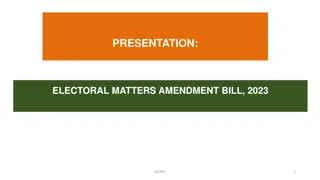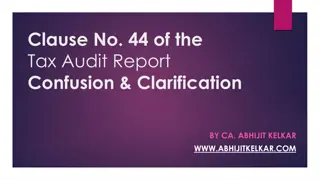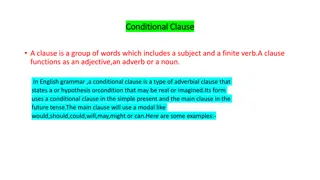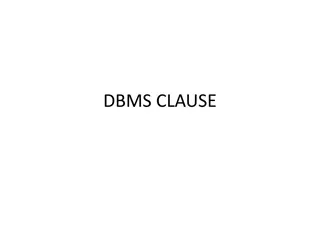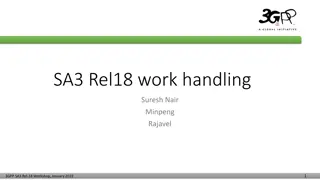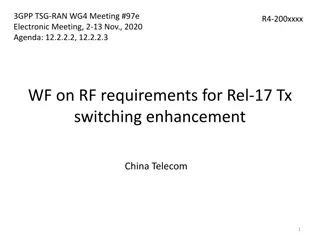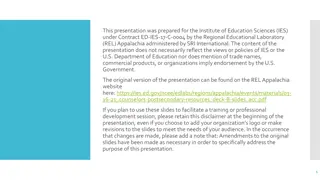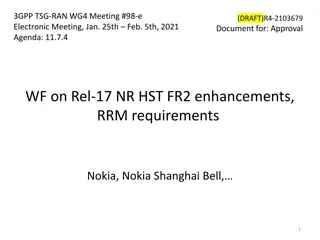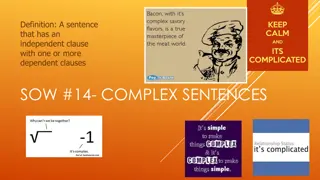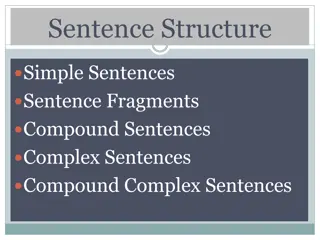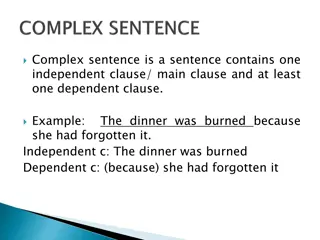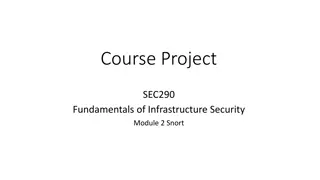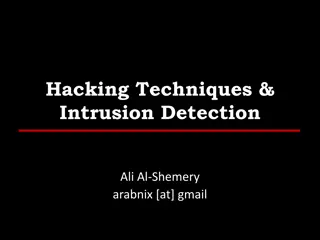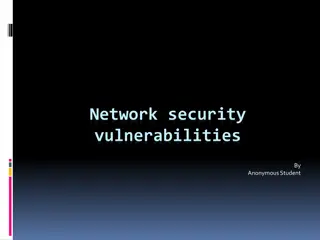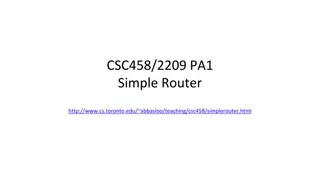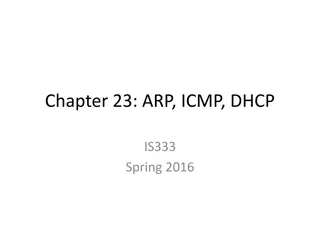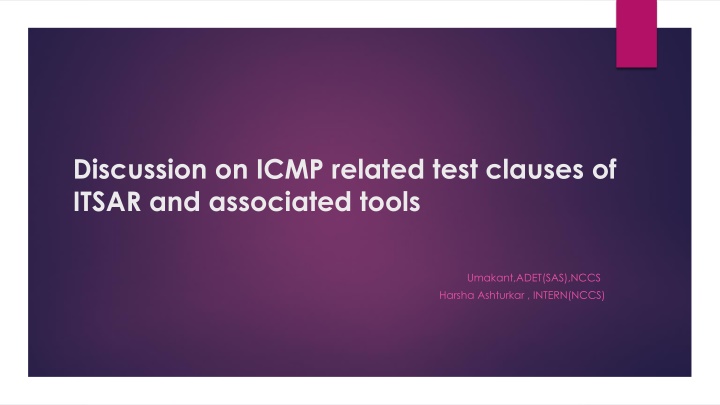
Understanding ICMP Test Clauses in ITSAR Requirements
Explore the ICMP-related test clauses of ITSAR and associated tools, covering the handling and processing requirements for ICMPv4 and ICMPv6 packets in network products. Learn about the decisive requirements and guidelines for certification testing.
Uploaded on | 0 Views
Download Presentation

Please find below an Image/Link to download the presentation.
The content on the website is provided AS IS for your information and personal use only. It may not be sold, licensed, or shared on other websites without obtaining consent from the author. If you encounter any issues during the download, it is possible that the publisher has removed the file from their server.
You are allowed to download the files provided on this website for personal or commercial use, subject to the condition that they are used lawfully. All files are the property of their respective owners.
The content on the website is provided AS IS for your information and personal use only. It may not be sold, licensed, or shared on other websites without obtaining consent from the author.
E N D
Presentation Transcript
Discussion on ICMP related test clauses of ITSAR and associated tools Umakant,ADET(SAS),NCCS Harsha Ashturkar , INTERN(NCCS)
Abbreviations TSTL: Telecom Security Test Lab ITSAR: Indian Telecom Security Assurance Requirement ICMP: Internet Control Message Protocol DUT: Device Under Test ETSI : European Telecommunications Standards Institute
Section 10.2 Handling of ICMP Requirement : Processing of ICMPv4 and ICMPv6 packets which are not required for operation shall be disabled on the Network product. ICMP message types which on receipt lead to responses or to configuration changes are not mentioned in this requirement, but they may be necessary to support relevant and specified networking features. Those must be documented. Certain ICMP types are generally permitted and do not need to be specifically documented. The Network product shall not send certain ICMP types by default, but it may support the option to enable utilization of these types (e.g., for debugging). This is marked as "Optional" in below table.
Table 2 : Decisive Requirements The Network product shall not respond to, or process (i.e., do changes to configuration), under any circumstances certain ICMP message types as mentioned in table below.
Summary ICMP packets under Table 1 are allowed for utilisation and are marked optional or permitted. However, for ICMP packets under Table 2 , only positive test outcomes lead to certification of the device. ICMP messages apart from those mentioned in the Table 1 and Table 2; which lead to response from DUT or cause configuration changes in the DUT must be documented.
ETSI TS 133 117 V14.2.0 (2017-07) Rel 14 recommendations Message/packet !=(malformed, irrelevant) Execution steps: The tester sends samples of the applicable ICMP messages from the tester machine to the network product and verifies by appropriate means that - the messages are dropped on receipt by the network product (e.g. by means of appropriate firewall rules), - or no response is sent out towards the test machine, - or there are other means ensuring that the ICMP messages cannot trigger a response/ cannot lead to configuration changes. - or the network product's applicable system configuration remains unchanged upon receipt of the messages. The test for this requirement can be carried out using a suitable tool or manually by performing the steps described. If a tool is used then the tester needs to provide evidence, e.g. by referring to the documentation of the tool, that the tool actually provides functionality equivalent to the steps.
Available open source tools Scapy Hping3 Nmap-nping
Case Study: Malformed Packet Malformed Packet - causes Incorrect Packet Length Truncated Packet Invalid Checksums Incorrect Protocol Headers Unexpected Payload Data Mismatched Protocol Layers Bit Errors (Corruption) Packet Fragmentation Issues DUT behaviour Drops or logs with destination unreachable Silently drops, etc. The crafted(scapy) ICMP packet is malformed.
Case Study: Well-formed but ineffective The crafted packet is well-formed but is ineffective.
Peeling back the layers redirect_packet= Outer IP header IP(src=Test Machine IP, dst= DUT IP)/ ICMP(code, gateway=new gateway)/ ICMP Header Original/Inner IP Header IP(src=DUT IP, dst=redirect target IP address)
Challenges before us Unavailability of test tool/expertise for sending relevant well-formed ICMP packets. Malformed packets are straightaway dropped by most of the DUTs and thus do not actually test the DUT, though it leads to a successful test performance. NCCS evaluator has to understand scripts/software used for packet crafting. Multi-disciplinary skills are required to perform tests or interpret the test results.
A solution ICMP test tool v1.0 ICMP messages as per the TCP /IP stack. Automates the full process of testing and report generation. Algorithm is pre decided- brings uniformity in analysis of test results. Demonstration
Table 2 Implemented Algorithm S. NoType Description Send Respond to Process (i.e. Algorithm* (IPv4/ v6) 5/137 do changes to configuration) Not Permitted Redirect NA NA Check for routing table changes/configurat ion Check for timestamp reply 1 13 Timestamp Request NA Not Permitted NA 2 * Not limited to the mentioned.
Table 2 Implemented Algorithm Type Description Send Respond to Process (i.e. Algorithm S. No do changes to configuration) NA 3 14 Timestamp Not Permitted NA Send an anomalous time stamp reply and compare DUT configuration. Send RS, Listen for RA. Reply 4 133 Router N/A Not Permitted Not Permitted Not Permitted Solicitation Router 5 134 N/A Not Permitted Send RA. DUT is expected to DROP RA packet. Check esp. for Default Gway. changes in config. Advertisement
Way forward TSTL generates the report using the ICMP test tool v1.0. TSTL submits the report along with the hash generated on the GUI. OEM declares optional ICMP messages used for debugging in the consolidated product information sheet.
Limitations of ICMP test tool v1.0 For estimating time changes in the DUT, the DUT should support NTP. For checking changes in device configuration, secure shell access is required.
Suggestion? Questions? uma.kant91@gov.in Thank you.

